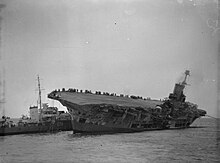Unsinkable Sam
| Species | Cat |
|---|---|
| Born | Before 1941 Nazi Germany |
| Died | 1955 Belfast, Northern Ireland, United Kingdom |
| Occupation | Ship's cat |
| Employer | Kriegsmarine Royal Navy |
| Notable role | Ship cat |
| External image | |
|---|---|
Unsinkable Sam (also known as Oskar or Oscar) is the nickname of a German ship's cat which purportedly saw service in both the Kriegsmarine and Royal Navy during the World War II.
History
The cat's original name is unknown. The name "Oscar" was given by the crew of the British destroyer HMS Cossack that rescued him from the sea following the sinking of the German battleship Bismarck. "Oscar" was derived from the International Code of Signals for the letter 'O', which is code for "Man Overboard"[1] (the German spelling, "Oskar", was sometimes used since he was a "German" cat).
Bismarck

The black and white patched cat had been owned by an unknown crewman of the German battleship Bismarck.[2] He was on board the ship on 18 May 1941 when she set sail on Operation Rheinübung, Bismarck's first and only mission. Bismarck was sunk after a fierce sea-battle on 27 May, from which only 118 from her crew of over 2,200 survived. Hours later, Oscar was found floating on a board and picked from the water, the only survivor (alongside 114 others) to be rescued by the homeward-bound British destroyer HMS Cossack.[3]: 142 Unaware of what his name had been on Bismarck, the crew of Cossack named their new mascot "Oscar".[3]: 142
HMS Cossack

The cat served on board Cossack for the next few months as the ship carried out convoy escort duties in the Mediterranean Sea and north Atlantic Ocean. On 24 October 1941, Cossack was escorting a convoy from Gibraltar to Great Britain when she was severely damaged by a torpedo fired by the German submarine U-563.[3]: 170 Crew were transferred to the destroyer HMS Legion, and an attempt was made to tow the badly listing Cossack back to Gibraltar. However, worsening weather conditions meant the task became impossible and had to be abandoned. On 27 October, a day after the tow was slipped, Cossack sank to the west of Gibraltar. The initial explosion had blown off one third of the forward section of the ship, killing 159 of the crew, but Oscar survived this too and was brought to the shore establishment in Gibraltar.[3]: 170
HMS Ark Royal

Now nicknamed "Unsinkable Sam", the cat was soon transferred to the aircraft carrier HMS Ark Royal, which coincidentally had been instrumental in the destruction of Bismarck (along with Cossack). However, Sam was to find no more luck there, and when returning from Malta on 14 November 1941 this ship too was torpedoed, this time by U-81. Attempts were also made to tow Ark Royal to Gibraltar, but the unstoppable inflow of water made the task futile. The carrier rolled over and sank 30 miles from Gibraltar. The slow rate at which the ship sank meant that all but one of the crew could be saved. The survivors, including Sam, who had been found clinging to a floating plank by a motor launch,[4] and described as "angry but quite unharmed"[5] were transferred to HMS Lightning and the same HMS Legion which had rescued the crew of Cossack. Legion would itself be sunk in 1942, and Lightning in 1943.
The loss of Ark Royal proved the end of Sam's shipborne career. He was transferred first to the offices of the Governor of Gibraltar and then sent back to the United Kingdom, where he saw out the remainder of the war living in a seaman's home in Belfast called the "Home for Sailors".[3]: 173 Sam died in 1955.[citation needed] A pastel portrait of Sam (titled Oscar, the Bismarck's Cat) by the artist Georgina Shaw-Baker is in the possession of the National Maritime Museum in Greenwich.[4]
Existence
Some authorities question whether Oskar/Sam's biography might be a "sea story", because - for example - there are pictures of two different cats identified as Oskar/Sam. The sinking of Bismarck and rescue of a limited number of survivors took place in desperate conditions; British ships were ordered not to stop as there was believed to be a U-boat in the area, and many survivors were left to drown. Pointedly, there is no mention of this incident in Ludovic Kennedy's detailed account of the sinking,[6] suggesting that information later gleaned from sailors regarding the cat's true service were apocryphal.[7]
References
- ^ Butkus, Venantas (8 July 2011). "The fame of ships' cats". jura.diena.lt. Retrieved 25 June 2017.
- ^ Stall, Sam (2007), 100 Cats Who Changed Civilization: History's Most Influential Felines, Quirk Books, pp. 57–58, ISBN 1-59474-163-8
- ^ a b c d e Piekałkiewicz, Janusz (1987). Sea War 1939-1945. Blandford. ISBN 0713716657.
- ^ a b Imperial War Museum, The Animals’ War: Special Exhibitions Gallery (pdf), retrieved 17 April 2013[dead link]
- ^ Jameson, William (2004), Ark Royal: The Life of an Aircraft Carrier at War 1939-41, Periscope Publishing, p. 348, ISBN 1-904381-27-8
- ^ Kennedy, Ludovic (2001). Pursuit: The Chase and Sinking of the Bismarck. Cassell & Co. ISBN 0304355267.
- ^ Baker, Georgina Shaw. "Item #PAJ2744: Oscar, Cat From the German Battleship Bismarck - Private Collections of the National Maritime Museum" (Framed drawing in pastel, 785 x 610 mm). Royal Museums Greenwich. London, UK.
Some doubt has been cast on Oscar's origins on the 'Bismarck' both for practical reasons, including there being no survivor account of him there, and because two contradictory photos exist.
Further reading
- Lewis, Val (2001). Ships' Cats in War and Peace. Shepperton: Nauticalia. ISBN 978-0-9530458-1-5.
- Vocelle, Laura. "Cats in 20th Century History (Cats in War-Unsinkable Sam)". thegreatcat.org.
